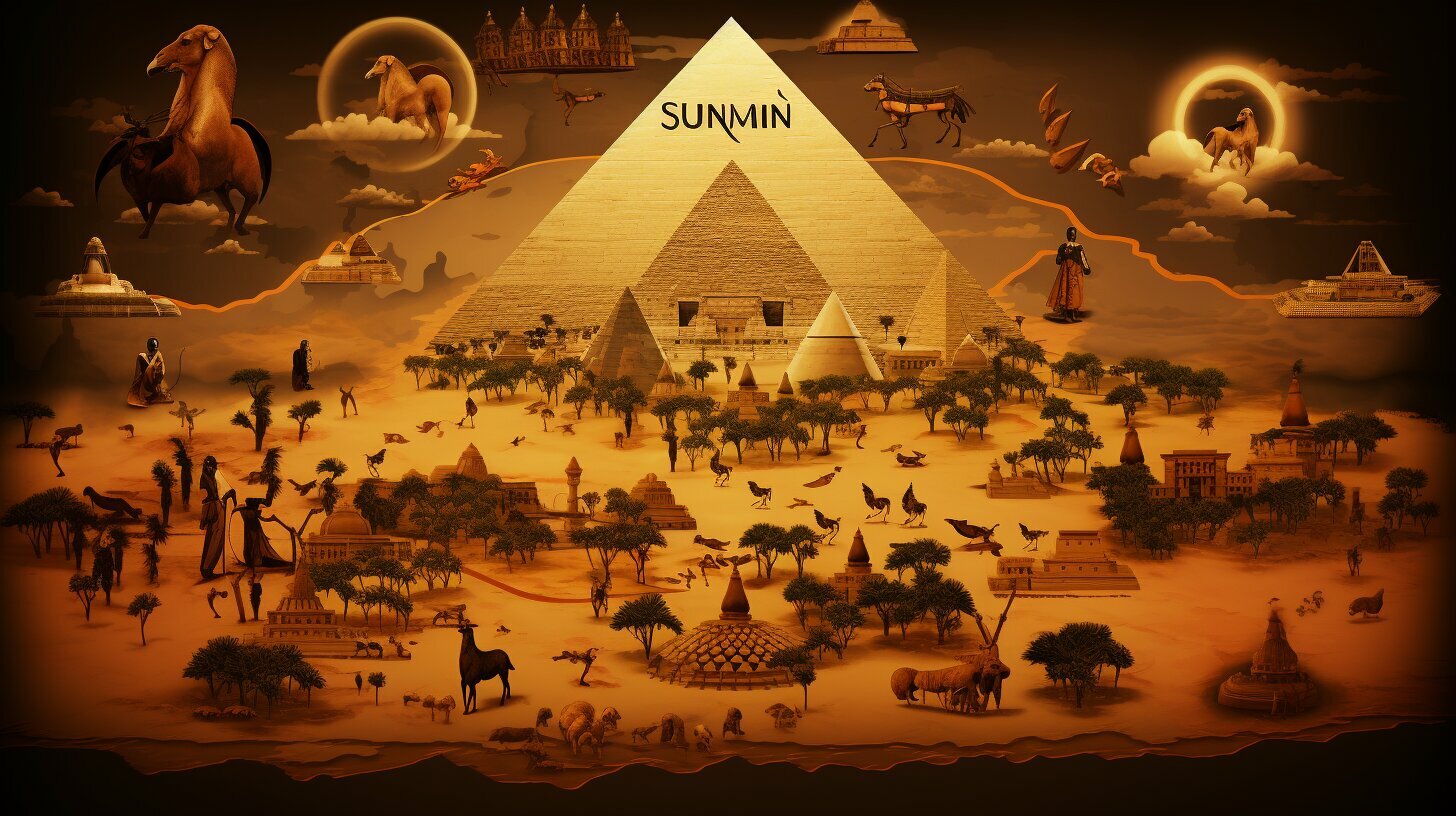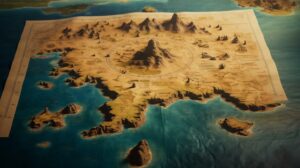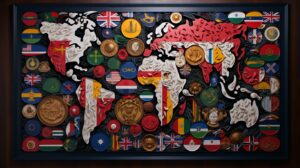Sudan is a country located in northeastern Africa, sharing borders with Egypt, Chad, Central African Republic, South Sudan, Ethiopia, Eritrea, Libya, and the Red Sea. It was the largest country in Africa until 2011 when South Sudan gained independence. The capital city of Sudan is Khartoum. The country is mainly composed of vast plains and plateaus, drained by the Nile River and its tributaries. Sudan has a hot climate with a rainy season in the central and southern regions. The country has a complex history characterized by conflict and political instability.
Key Takeaways:
- Sudan is located in northeastern Africa.
- It shares borders with Egypt, Chad, Central African Republic, South Sudan, Ethiopia, Eritrea, Libya, and the Red Sea.
- The capital city of Sudan is Khartoum.
- Sudan is mainly composed of vast plains and plateaus.
- The country has a hot climate with a rainy season in the central and southern regions.
Sudan’s Geographical Features
The land of Sudan is mainly composed of expansive plains and plateaus, which are nourished by the Nile River and its tributaries. This geographical makeup has significant implications for the country’s agriculture, transportation, and overall development.
The Nile River, one of the world’s longest rivers, flows through Sudan, providing a vital source of water and fertile soil for farming. Its tributaries, such as the Blue Nile and the White Nile, also play a crucial role in sustaining the agricultural activities in the region. Farmers rely on these water sources for irrigation, enabling the cultivation of crops like cotton, sorghum, and sesame.
Sudan’s plains and plateaus offer vast grazing lands for livestock, making animal husbandry an important aspect of the country’s economy. The region is known for its rich biodiversity, with diverse wildlife, including elephants, giraffes, lions, and a variety of bird species.
| Geographical Features of Sudan | Description |
|---|---|
| Plains and Plateaus | Sudan is characterized by extensive plains and plateaus, which provide ideal conditions for agriculture and livestock farming. |
| The Nile River | The Nile River, along with its tributaries, flows through Sudan, serving as a lifeline for irrigation and supporting a thriving agricultural sector. |
| Wildlife | Sudan’s diverse geography supports a rich variety of wildlife, including elephants, giraffes, lions, and numerous bird species. |
In addition, Sudan’s geographical features have influenced the country’s transportation networks. The Nile River has historically been used as a means of transportation, facilitating trade and commerce within Sudan and beyond. The river continues to be an important route for transporting goods and people, particularly in the central and northern regions.
Overall, Sudan’s geographical features contribute to its agricultural productivity, support a thriving ecosystem, and shape its transportation infrastructure. Understanding these key aspects is essential for comprehending the country’s unique identity and potential for development.
Sudan’s Climate
Sudan experiences a hot climate, with a distinct rainy season in its central and southern regions. The country’s geographical location and topography contribute to its unique weather patterns. The climate in Sudan can be categorized as tropical desert, characterized by high temperatures and limited rainfall.
During the rainy season, which typically occurs from May to October, Sudan receives the majority of its annual rainfall. The central and southern regions of the country experience the highest precipitation during this time, with heavy downpours and occasional thunderstorms. These rains are vital for agriculture and help sustain local ecosystems, providing a lifeline for both people and wildlife.
In contrast, the northern and western parts of Sudan are arid and experience scarce rainfall. These areas are primarily composed of deserts and semi-arid landscapes, where the hot and dry climate prevails throughout the year. Temperatures in Sudan can soar to extreme levels, especially during the summer months, reaching highs of over 40 degrees Celsius (104 degrees Fahrenheit).
Overall, Sudan’s climate reflects its location within the Sahelian and Saharan regions of Africa. The country’s weather patterns are influenced by the tropical monsoon system, which brings moisture from the Indian Ocean and the Congo Basin. While Sudan’s climate presents challenges, its diverse geography and natural resources contribute to the richness and resilience of its ecosystems and communities.
Climate Overview
| Region | Climate |
|---|---|
| Central and Southern Sudan | Hot desert climate with a rainy season from May to October |
| Northern and Western Sudan | Arid and very hot desert climate with limited rainfall |
Sudan’s Historical Significance
Sudan carries a rich historical significance, marked by a complex history of conflicts and political instability, being part of the African continent. Located in northeastern Africa, Sudan shares borders with Egypt, Chad, Central African Republic, South Sudan, Ethiopia, Eritrea, Libya, and the Red Sea. Until 2011, Sudan held the title of being the largest country in Africa until South Sudan gained independence.
The capital city of Sudan is Khartoum, which serves as a vibrant hub and holds great significance for both historical and political reasons. Sudan’s geographical features consist of vast plains and plateaus, with the Nile River and its tributaries playing a significant role in shaping the landscape. The country’s hot climate is characterized by a distinct rainy season in the central and southern regions.
Throughout its history, Sudan has faced numerous challenges and conflicts, shaping its political landscape. The country has witnessed power struggles, civil wars, and ethnic tensions, leading to periods of instability. Despite these challenges, Sudan remains an important country in Africa, with a diverse population and a history deeply intertwined with the continent.
Sudan’s Capital City
The capital city of Sudan is Khartoum, a vibrant and culturally diverse city that serves as the political and economic center of the country. Nestled at the confluence of the Blue Nile and White Nile rivers, Khartoum offers stunning views of the riverbanks and a bustling urban landscape. It is the largest city in Sudan, with a population of over 5 million people.
Historical Significance
Khartoum has played a significant role in Sudan’s history. It was established in the 19th century as a military outpost by the Egyptians, and later became a major trading center during the Anglo-Egyptian Sudanese administration. The city witnessed pivotal events, including the Mahdist Revolution against British colonial rule and the signing of the Comprehensive Peace Agreement, which ended the long-standing civil war between the north and south of Sudan.
Modern Khartoum is a bustling metropolis with a mix of modern and traditional architecture. It boasts a vibrant street life, historical landmarks, and cultural attractions. Visitors can explore the National Museum of Sudan, which houses ancient artifacts and archaeological treasures, or take a stroll along the Nile Street promenade, lined with cafes and restaurants offering panoramic views of the river.
| Capital City | Population | Geographical Location |
|---|---|---|
| Khartoum | Over 5 million | At the confluence of the Blue Nile and White Nile rivers |
With its rich history and cultural significance, Khartoum is a city worth exploring for both locals and tourists. Its bustling markets, traditional music, and warm hospitality make it an unforgettable destination in Sudan.
Sudan’s Former Status and Current Situation
Sudan was the largest country in Africa until 2011 when South Sudan gained independence, and it continues to undergo various developments and changes in the present day. Located in northeastern Africa, Sudan shares borders with Egypt, Chad, Central African Republic, South Sudan, Ethiopia, Eritrea, Libya, and the Red Sea. Its geographical landscape mainly consists of vast plains and plateaus, which are drained by the magnificent Nile River and its tributaries.
With a hot climate, Sudan experiences a rainy season in the central and southern regions, providing relief from the otherwise scorching temperatures. However, the country’s history has been marked by conflict and political instability, leading to significant challenges and transformations. Sudan, being a part of the African continent, is known for its complex historical significance that has shaped its current state.
The capital city of Sudan is Khartoum, a vibrant and bustling city. Khartoum serves as the economic, cultural, and political center of the country, with its own unique charm and noteworthy features. The city reflects the diversity and resilience of Sudanese culture and offers a captivating blend of modernity and tradition.
As Sudan continues to navigate its path in the present day, it remains a country with rich cultural heritage, breathtaking natural beauty, and a population that strives for stability and progress. Despite the challenges it has faced, Sudan is a nation with immense potential and a story that is still unfolding, making it an intriguing and captivating destination for exploration and understanding.
FAQ
Q: What country is Sudan in?
A: Sudan is located in northeastern Africa.
Q: What are Sudan’s geographical features?
A: Sudan is mainly composed of vast plains and plateaus, drained by the Nile River and its tributaries.
Q: What is the climate like in Sudan?
A: Sudan has a hot climate with a rainy season in the central and southern regions.
Q: What is the historical significance of Sudan?
A: Sudan has a complex history characterized by conflict and political instability. It is also part of the African continent.
Q: What is the capital city of Sudan?
A: The capital city of Sudan is Khartoum.
Q: What was Sudan’s former status and what is its current situation?
A: Sudan was the largest country in Africa until 2011 when South Sudan gained independence. The current situation in Sudan may vary and is subject to recent developments and changes.



